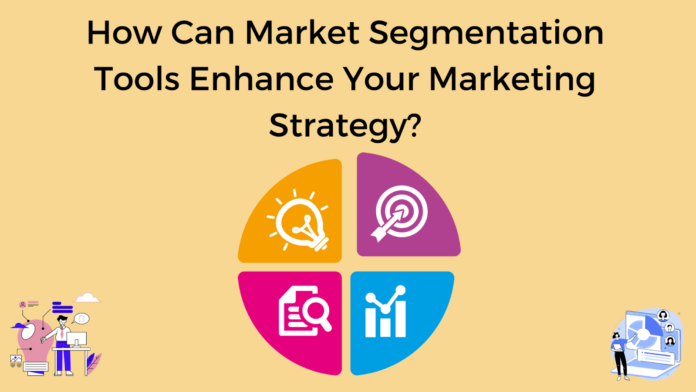Today’s crowded digital landscape demands more than a broad messaging strategy can offer. You need it to reach your target audience. With so many competing brands and touchpoints, customers have endless options to choose from. To cut through the noise, marketers need to get personal. This is where market segmentation comes in.
Market segmentation is the process of dividing your overall target market into smaller, distinct groups using audience segmentation tools. These groups share similar characteristics. By catering messaging and offerings directly to the needs, behaviors, and preferences of these niche segments. Brands can enhance engagement and drive conversions.
The key lies in truly understanding your diverse customer base – but how? This article explores how employing the right market segmentation tools can provide the insights you need to take your marketing strategy to the next level.
Why Market Segmentation Matters
In the past, mass marketing techniques tried to engage as many people as possible. They assumed that a broad campaign would reach enough customers to be worthwhile. However, buyer behavior today shows an entirely different landscape:
Customers crave personalization. 76% of consumers expect personalized content and offers from brands. Niche communities are emerging. People are joining smaller subgroups centered on specific interests, values, and priorities.
Shorter attention spans prevail nowadays. You now have mere seconds to grab someone’s interest before they disengage. This dynamic landscape demands a more targeted approach to reach customers effectively. Segmenting your audience into smaller groups helps address the diverse needs of today’s market. It drives real results.
Now that the importance of segmentation is clear, let’s look at some data. The usage of Market segmentation tools has steadily increased over the past 5 years as shown below:
As the graph illustrates, segmentation tools have become a critical component of marketing strategies as personalization and niche communities continue to grow.
The benefits of Market Segmentation
Campaigns tailored to customer subgroups improve conversion rates by 200-300% compared to generic outreach.
Better ROI – Companies see $20-$30 in revenue for every $1 spent on personalized marketing through segmentation.
Enhanced customer lifetime value – Personalized experiences build loyalty and brand affinity with niche audiences.
More efficient spending – Target only viable customers open to your offerings instead of spraying the masses.
Now that the importance of segmentation is clear, let’s explore best practices for doing it effectively using the latest tools.
Key Segmentation Strategies
Many approaches exist for segmenting your customer base. Common segmentation strategies include:
Psychographic
Psychographic segmentation divides target audiences into subgroups based on psychological qualities and tendencies using segmentation tools. It does not rely solely on demographic attributes. This provides unique and detailed profiles. They reflect personality traits, opinions, interests, lifestyles, values, and more. The insights empower resonating messaging.
An outdoor apparel brand, for example, may segment customers based on thrill-seeking behaviors. They may also reference groups valued for their adventure knowledge. The marketing can then feature daring expeditions. Psychographic segmentation enables looking beyond age and location. This helps to craft content that strikes an emotional chord for relevance.
Technographic
Technographic segmentation focuses on how customers interact with technology tools and channels. It examines this interaction across their buyer’s journey. It does not focus on who they are fundamentally. This showcases their digital body language. It includes site navigation patterns, device preferences, platform engagement levels, software familiarity, and more.
For instance, an enterprise software company identified a niche subgroup using competitor tools. The company is open to new options. By serving targeted advertisements to these technographic segments during key decision windows, they expanded their addressable market. Technographics reveal online behaviors otherwise hidden behind demographic generalities.
Demographic
Demographic segmentation differentiates groups based on age, income, education, gender, occupation, geographical location, and other immutable attributes. This foundational approach powered marketing for decades. Demographics provide a baseline orientation but lack the richness to spark meaningful connections.
This richness is absent from other data streams. While foundational, exclusively demographic-based outreach can miss the mark due to superficial messaging. However, incorporating psychographic and behavioral facets into demographic subgroups creates impactful segments.
Behavioral
Behavioral segmentation categorizes customers based on actions taken rather than static traits. This shifts focus from who people are to what they do. This includes online engagement metrics, keyword searches, content consumption patterns, and product usage frequency. It also includes past purchase data, customer journey stages, and more.
The signals provide tangible intent indicators that predictive analytics platforms leverage for personalization. Behavioral cuts deepest to motivations. For example, an electronics retailer’s abandoned cart save campaigns focus solely on past demonstrated purchase interest. They do not spray the broad email list.
Layering these methodologies provides a multidimensional view of your customers for the most intelligent subgroups to guide strategy. Now let’s explore the tools that bring segmentation approaches to life.
Powerful Market Segmentation Tools
Sophisticated tools now enable marketers to slice and dice customer data to reveal strategic subgroups at scale. Here are 5 top-rated market segmentation tools:
| Tool | Key features |
| Survicate | Visitor profiling, feedback surveys, NPS tracking |
| Reveal Bot | Predictive models, personalized nudges, anomaly detection |
| MailChimp | Grouping tools, targeted email campaigns, Automation workflows |
| Google Analytics | Custom/smart segments, cohort analysis, funnel optimization |
| HubSpot | Lead scoring, life cycle stage segmentation, sales integration |
These platforms offer robust segmentation capabilities. For example, they have predictive models, custom subgrouping, niche audience discovery, detailed reporting and analytics, and more. The key is matching business needs to tool functionality.
For instance, Survicate and Reveal Bot specialize in capturing visitor intent through granular behavioral analysis. HubSpot and MailChimp focus more on integrating insights across sales and marketing workflows.
The right tools uncover strategic subgroups from market noise. They enable the next phase: Application.
Applying Segmentation Strategies
Marketers can craft targeted campaigns hyper-relevant to niche audiences by using customer insights. This drives engagement and conversions.
Advanced segmentation identifies strategic subgroups. Brands can then use these insights for resonance. This involves crafting targeted campaigns, messaging, and experiences tailored to the unique needs and preferences of each audience cluster. The clusters are uncovered through analysis.
For example, an automotive company uses purchase data and behavioral metrics. This reveals a hyper-loyal subset of customers concentrated around truck and SUV models. Serving this niche group specialized promotions and personalized email journeys focused on rugged utility vehicles sparks greater engagement and trade-in rates. This is relative to general incentives.
Additionally, demographic data indicates that the brand’s smaller sedan segment trends younger and is more budget-conscious, often aligned with ridesharing. This group receives messaging showcasing efficiency, tech features, and flexible lease options. These are the selling points.
These strategies involve translating segmentation insights into resonating messaging and offers. Now let’s examine measuring impact.
Evaluating Segmentation Success
While applying segmentation, track key metrics gauging marketing effectiveness for each niche group:
Key Performance Indicators (KPIs)
- Clickthrough Rate
- Cost Per Lead
- Engagement Time
- Purchase Frequency
- Lifetime Value
- Conversion Rate
Compare segmented campaign metrics versus past mass outreach numbers to quantify the impact. Factor subgroup size, growth potential, and cost to serve into evaluations.
Adjust segmentation parameters and campaigns in real time based on measured results. Ongoing optimization is key for maximum return on investment.
Frequently Asked Questions
1. How do segmentation tools integrate with other marketing platforms?
Many tools like HubSpot and MailChimp offer built-in CRM, email services, and ad integrations. They allow syncing segment insights across channels for a unified view of customer interactions.
2. Can small businesses benefit from segmentation?
Absolutely. Many highlighted tools offer free plans. They also have scalable pricing suitable for early-stage and resource-constrained teams. Startups can unlock significant advantages using segmentation compared to generalist competitors.
3. Which tool option works best for predictive segmentation?
Platforms like Reveal Bot and Evergage utilize machine learning algorithms to analyze customer data and behaviors. They predict preferences and churn risks for identified microsegments. Their advanced capabilities best enable predictive segmentation.
Conclusion
Market segmentation provides a proven way to drive marketing success, but achieving it requires focus. Start by identifying strategic customer subgroups. Use demographic, psychographic, behavioral, and other insight streams.
Equip yourself with solutions purpose-built to handle segmentation at scale. Apply findings by crafting targeted campaigns and messaging to delight priority niches.
Continuously measure performance through niche-specific KPIs, tweaking approaches in real-time to maximize outcomes. Getting personal with your audience pays off – the results will show.





